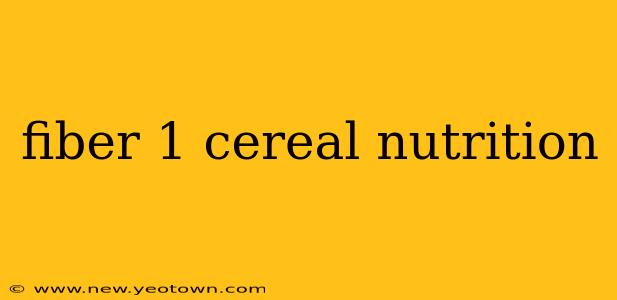Fiber One cereal has become a staple in many health-conscious households, known for its high fiber content and relatively low calorie count. But what exactly is in this popular breakfast choice, and does it live up to its nutritional claims? Let's unravel the nutritional profile of Fiber One cereal and explore its impact on your health. This isn't just a simple nutritional breakdown; we'll delve into the specifics, answering common questions and addressing concerns.
What are the key nutrients in Fiber One cereal?
Fiber One cereal's claim to fame lies in its substantial fiber content. A single serving typically boasts around 14 grams of fiber, significantly exceeding the recommended daily intake for many adults. This high fiber content contributes to several health benefits, as we'll discuss later. Beyond fiber, Fiber One cereals offer varying amounts of vitamins and minerals depending on the specific variety. Check the nutrition label on your box for the precise vitamin and mineral profile, as it can vary slightly. Typically, you can expect some vitamins and minerals, but they aren’t usually the primary focus of this cereal.
How many calories are in a serving of Fiber One cereal?
Calorie content also varies depending on the specific Fiber One cereal type. However, generally, a serving is relatively low in calories compared to many other breakfast cereals, often falling in the range of 50-90 calories per serving. This makes it a potentially attractive option for those watching their weight. Remember, though, that adding milk, fruit, or sweeteners will significantly increase the calorie count.
Is Fiber One cereal good for weight loss?
The high fiber content and relatively low calorie count of Fiber One cereal make it a potential aid in weight loss efforts. Fiber helps you feel full and satisfied, reducing cravings and overeating. However, it's crucial to remember that Fiber One cereal is only one piece of the weight-loss puzzle. A balanced diet, regular exercise, and a healthy lifestyle are essential for achieving and maintaining a healthy weight. Don't rely on only Fiber One cereal for weight loss.
What are the potential health benefits of eating Fiber One cereal?
The significant health benefits of Fiber One cereal primarily stem from its high fiber content. Fiber promotes healthy digestion, preventing constipation and promoting regularity. It can also help lower cholesterol levels and regulate blood sugar, contributing to overall cardiovascular health. The added vitamins and minerals can also contribute to overall wellness. However, relying solely on cereal for your nutrients isn’t recommended - a balanced diet is key.
Does Fiber One cereal cause bloating or gas?
While fiber is beneficial for digestion, some individuals may experience bloating or gas when significantly increasing their fiber intake. This is often temporary as your body adjusts to the increased fiber. If you experience these symptoms, start by gradually increasing your Fiber One consumption and drinking plenty of water. If symptoms persist, consult your doctor.
What are the potential downsides or drawbacks of Fiber One cereal?
Despite its nutritional benefits, Fiber One cereal has potential downsides. Some find the texture to be quite coarse and dry. It can be improved with milk or yogurt, but that can raise calorie count. Additionally, it's important to remember that Fiber One is not a complete nutritional source. It is best consumed as part of a balanced diet.
Is Fiber One cereal suitable for people with diabetes?
The high fiber content in Fiber One cereal can help regulate blood sugar levels. Fiber slows down the absorption of sugar into the bloodstream, preventing sharp spikes in blood glucose. However, individuals with diabetes should still monitor their blood sugar levels closely and consult with their doctor or a registered dietitian for personalized dietary advice.
In conclusion, Fiber One cereal offers a convenient way to increase your fiber intake, supporting digestive health and potentially aiding in weight management. However, remember it’s just one component of a healthy diet. A varied and balanced nutritional plan, coupled with regular exercise and a healthy lifestyle, are key for optimal health and well-being. Always read the nutrition label and consult with a healthcare professional if you have concerns about incorporating Fiber One cereal into your diet.

